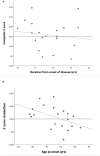Cerebellar and Cerebral Amyloid Visualized by [18F]flutemetamol PET in Long-Term Hereditary V30M (p.V50M) Transthyretin Amyloidosis Survivors
- PMID: 35317351
- PMCID: PMC8934387
- DOI: 10.3389/fneur.2022.816636
Cerebellar and Cerebral Amyloid Visualized by [18F]flutemetamol PET in Long-Term Hereditary V30M (p.V50M) Transthyretin Amyloidosis Survivors
Abstract
Introduction: Hereditary transthyretin (ATTRv) amyloidosis caused by the V30M (p. V50M) mutation is a fatal, neuropathic systemic amyloidosis. Liver transplantation has prolonged the survival of patients and central nervous system (CNS) complications, attributed to amyloid angiopathy caused by CNS synthesis of variant transthyretin, have emerged. The study aimed to ascertain amyloid deposition within the brain in long-term ATTRv amyloidosis survivors with neurological symptoms from the CNS.
Methods: A total of 20 patients with ATTR V30M having symptoms from the CNS and a median disease duration of 16 years (8-25 years) were included in this study. The cognitive and peripheral nervous functions were determined for 18 patients cross-sectionally at the time of the investigation. Amyloid brain deposits were examined by [18F]flutemetamol PET/CT. Five patients with Alzheimer's disease (AD) served as positive controls.
Result: 60% of the patients with ATTRv had a pathological Z-score in the cerebellum, compared to only 20% in the patients with AD. 75% of the patients with transient focal neurological episodes (TFNEs) displayed a pathological uptake only in the cerebellum. Increased cerebellar uptake was related to an early age of onset of the ATTRv disease. 55% of the patients with ATTRv had a pathological Z-score in the global cerebral region compared to 100% of the patients with AD.
Conclusion: Amyloid deposition within the brain after long-standing ATTRv amyloidosis is common, especially in the cerebellum. A cerebellar amyloid uptake profile seems to be related to TFNE symptoms.
Keywords: [18F]flutemetamol; amyloid angiopathy; amyloidosis-hereditary; positron emission tomography; transthyretin.
Copyright © 2022 Uneus, Wilhelmsson, Bäckström, Anan, Wixner, Pilebro, Riklund, Ögren, Ögreen, Axelsson, Suhr and Sundström.
Conflict of interest statement
The authors declare that the research was conducted in the absence of any commercial or financial relationships that could be construed as a potential conflict of interest.
Figures



Similar articles
-
Distribution and progression of cerebral amyloid angiopathy in early-onset V30M (p.V50M) hereditary ATTR amyloidosis.Amyloid. 2023 Mar;30(1):109-118. doi: 10.1080/13506129.2022.2128331. Epub 2022 Sep 30. Amyloid. 2023. PMID: 36178174
-
Quantification of cardiac amyloid with [18F]Flutemetamol in patients with V30M hereditary transthyretin amyloidosis.Amyloid. 2020 Sep;27(3):191-199. doi: 10.1080/13506129.2020.1760237. Epub 2020 May 13. Amyloid. 2020. PMID: 32400202
-
Pathogenesis, manifestations, diagnosis, and management of CNS complications in hereditary ATTR amyloidosis.Amyloid. 2025 Jun;32(2):117-128. doi: 10.1080/13506129.2024.2435573. Epub 2024 Dec 3. Amyloid. 2025. PMID: 39627935 Review.
-
Cerebral amyloid angiopathy in posttransplant patients with hereditary ATTR amyloidosis.Neurology. 2016 Aug 23;87(8):773-81. doi: 10.1212/WNL.0000000000003001. Epub 2016 Jul 27. Neurology. 2016. PMID: 27466465
-
CNS Involvement in Hereditary Transthyretin Amyloidosis.Neurology. 2021 Dec 14;97(24):1111-1119. doi: 10.1212/WNL.0000000000012965. Epub 2021 Oct 18. Neurology. 2021. PMID: 34663645 Review.
Cited by
-
Exploring cognitive functions and brain structure in Hereditary Transthyretin amyloidosis using brain MRI and neuropsychological assessment.Neurol Sci. 2025 Mar;46(3):1349-1358. doi: 10.1007/s10072-024-07846-5. Epub 2024 Nov 5. Neurol Sci. 2025. PMID: 39499456
-
Cognitive manifestations and brain integrity in hereditary transthyretin amyloidosis: a systematic review.J Neurol. 2025 May 25;272(6):419. doi: 10.1007/s00415-025-13120-1. J Neurol. 2025. PMID: 40413714 Review.
-
Molecular Design of Magnetic Resonance Imaging Agents Binding to Amyloid Deposits.Int J Mol Sci. 2023 Jul 6;24(13):11152. doi: 10.3390/ijms241311152. Int J Mol Sci. 2023. PMID: 37446329 Free PMC article. Review.
References
-
- Andersson R. Familial amyloidosis with polyneuropathy. A clinical study based on patients living in northern Sweden. Acta Med Scand Suppl. (1976) 590:1–64. - PubMed
-
- Rowczenio D, Wechalekar A. Mutations in Hereditary Amyloidosis. Available online at: http://amyloidosismutations.com/ (accessed January 20, 2022).
LinkOut - more resources
Full Text Sources
Research Materials

